Recent history has shown that
there is no universally-accepted criteria for the NBA’s Most
Valuable Player award. It’s about winning. It’s about stats. It’s
about impact. It’s about the storyline -- boy, do we, collectively,
love a good storyline. That concoction of ideals, however you split
them in your importance pie, is how the MVP is decided. The
“valuable” portion in MVP is intentionally vague for that very
reason: for voters to decide what matters the most.
With that being said, I have a
very simple question: why the heck are we overthinking
this?
To be more frank about it: why
the heck is Giannis Antetokounmpo getting screwed in the MVP race
right now?
Before moving forward, it’s
important to point out that this year’s race is pretty stacked.
Joel Embiid and LeBron James have put together fantastic two-way
seasons with the insane on-off splits usually affiliated with MVP
winners. Nikola Jokic and Damian Lillard have had to carry insane
offensive loads due to the injuries and/or defensive ineptitude
around them. James Harden is in that class too, though he’s been
sandwiched between (offensive) superstars since forcing his way to
Brooklyn.
Cool. Pleasantries out of the
way. The NBA is a talented league, etc. Here’s the kicker: Giannis’
case for MVP is just as good, if not flat-out better.
THE NARRATIVE
The narrative portion is what
seems to be keeping Giannis out of the highest tier of MVP
candidates. He’s failed in two straight postseasons, both of which
came after winning the MVP award. Winning three MVPs in a row is
hard; doing so after leaving a sour taste in the mouths of voters
due to second-round flubbings puts the difficulty level on Hall of
Fame.
Put another way: voter fatigue
is a real thing, and Giannis has done himself no favors by coming
up short in two consecutive postseasons.
Speaking of the Hall of Fame,
only three players -- Bill Russell, Wilt Chamberlain, Larry Bird --
have won three MVPs in a row. And as ESPN’s Zach Lowe pointed out
on his latest podcast, all three of those players won rings in the
midst of their three-peats.
Now, factoring in (a lack
of) playoff
success for a
regular-season
award is pretty stupid for reasons
I should not have to spell out. As inherently silly as it is,
it does
matter. But if the postseason
narrative is going to matter, why not spin this the other
way?
The Bucks’ (read: Giannis’)
shortcomings in the postseason have boiled down to a lack of
flexibility. No counters in the half-court, no counters
defensively.
You knew the drill when the
Bucks came into town. They were going to give Giannis the ball at
the top of the key, five-out alignment around him, and bludgeon you
with shots at the rim or easy kick-outs for three. On defense, they
were going to play a deep drop coverage in order to wall off the
rim, and dare you to beat them with pull-up threes.
The Raptors did just that in
2019, throwing a multitude of All-Defensive team-caliber bodies at
Giannis while forming a wall outside of the paint. Mix in some
tough-shot goodness from Kawhi Leonard and Fred VanVleet torching
the nets over the back-half of the series, and the Bucks went
home.
The Heat followed a similar
formula the following season. Jae Crowder got the primary
assignment, with Bam Adebayo and Jimmy Butler coming with timely
digs at the nail or shot contests at the rim. Mix in some
tough-shot goodness from Butler and Crowder torching the nets over
the front-half of the series, and the Bucks went home.
So, what did the Bucks do? What
did Giannis do? This season, they’ve altered their
approach.
Gone (mostly, anyway) is the
five-out alignment, instead replaced with a four-out, one-in style
that stashes a guy in the dunker spot. Gone is the
reliance
of drop coverage -- and Giannis
operating as a weak side helper for what felt like 90 percent of
the time -- instead replaced by some much-needed diversity. There’s
more switching on the perimeter. There’s more hedging. There are
more possessions where Brook Lopez is venturing out of the
paint.
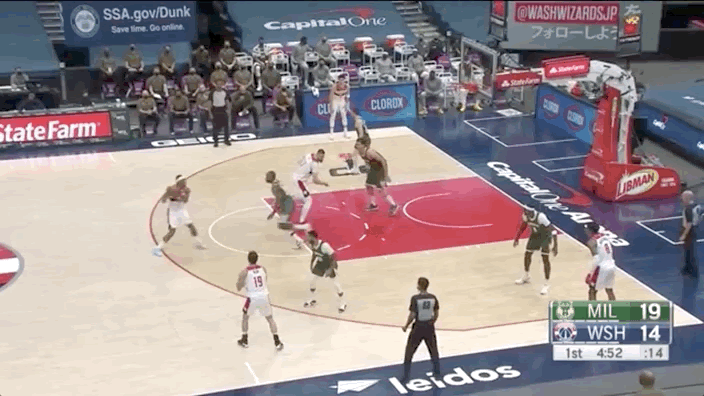
So, let’s start there. The Bucks
are using their previous failures -- against really freaking good
teams, by the way -- to inform their plan this season. They’ve been
intentional about going through uncomfortable growing pains. That’s
a team-wide thing, but it especially applies to
Giannis.
And he’s still been dominant.
THE ON-COURT CASE
Let’s not get it twisted:
Giannis knows where his bread is buttered. He remains the NBA’s
most dominant paint presence, even with a teammate occupying some
of that space on a regular basis.
Per PBP
Stats, Giannis has
converted 79.6% of his 377 rim attempts this season. If that
efficiency holds, it’ll eclipse his previous career-high by nearly
six percentage points. Of the 56 players that have taken at least
150 shots at the rim so far, nobody has been a more reliable
finisher.
The leaderboard of rim
efficiency is filled with traditional big men; seven of the top 10
are centers -- eight if you’re counting Bam Adebayo as traditional
-- while LeBron James and Giannis represent the outliers. They’re
the only two in the top 10 to be assisted on fewer than half of
their rim attempts.
We know about Giannis’ power.
Putting smaller defenders on him is a futile effort. We also know
how deadly he is when he goes off-beat, slithering past
over-pursuing defenders by decelerating and utilizing elongated
steps, or spinning off for dunks or lay-ups.
We’re starting to see more
counters. Take this possession against Defensive Player of the Year
candidate Ben Simmons:
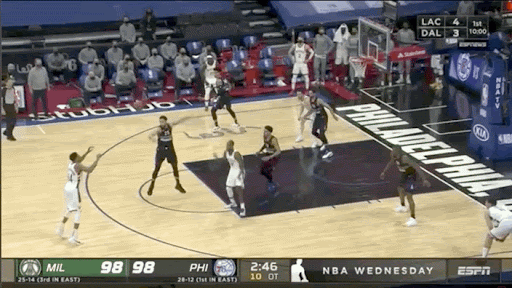
If you blink, you’ll miss the
goodness. Giannis attacks Simmons’ front foot after the lunge.
Simmons flips his hips to slide with Giannis. Watch the second
dribble after the drive; it’s a hard pound and a slight hesi.
Simmons stumbles because he’s anticipating a left-to-right spin
move; instead, Giannis gains more leverage, ducking underneath
Simmons before flipping up the lay-in.
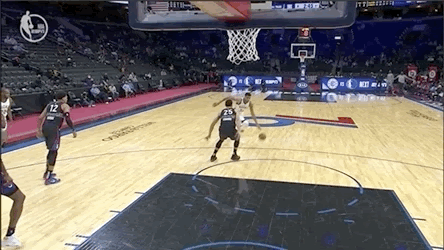
There’s been growth as a passer
as well. That’s reflected in the raw numbers -- his 6.2 assists
would be a career-high and his turnovers are slightly down from
last season -- but the process has been more encouraging. Giannis’
processing speed has increased, allowing him to capitalize against
shifting or preoccupied defenses in a more timely
manner.
Having a roamer along the
baseline gives him a built-in read in isolation or post-up
situations.
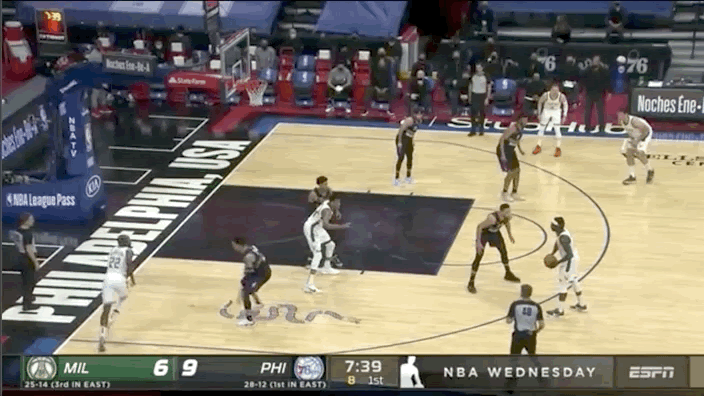
But you can also see him making
kick-outs a little quicker. Placement remains an issue while
passing on the move, but the fact that he’s getting those passes
out earlier has allowed his teammates to readjust before the
defense is able to recover.
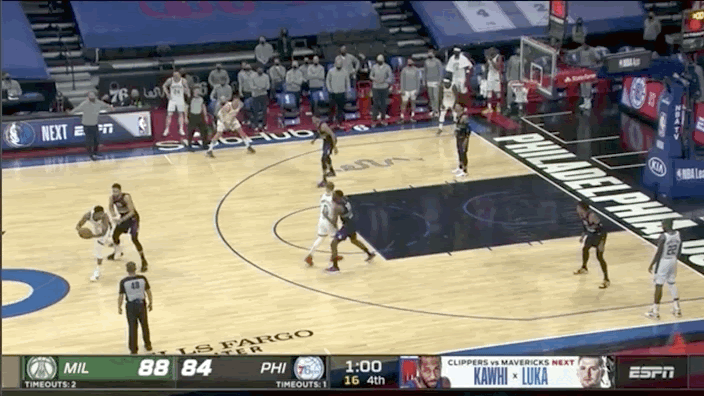
Defensively, we’ve seen a slight
shift in Giannis’ usage. He’s taken on more on-ball responsibility,
the most-notable examples recently being his assignment against
Kawhi Leonard in a 105-100 win versus the Clippers and reps against
Russell Westbrook in back-to-back victories against the Wizards
earlier this week.
Fighting over screens is
certainly out of Giannis’ comfort zone; he isn’t able to get skinny
and stay attached as easily as a guard would. What he lacks in
slippery screen avoidance, he makes up for in being arguably the
league’s most dangerous rearview contest machine.
Pop on a random Bucks game and
you’re bound to see more possessions like this:
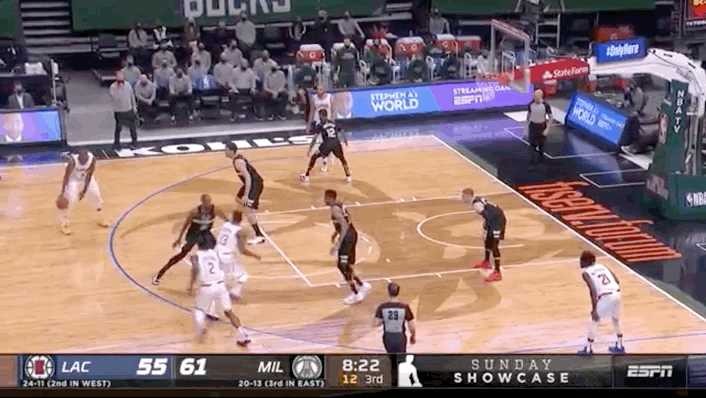
He’s been a beast as a switch
defender, a development that should surprise no one. Because of his
lateral quickness and length, he’s been able to corral perimeter
players in space. He then doubles as an effective rim protector
because of his size and, well, length. To that point: the Bucks
have blitzed teams by over 14 points per 100 possessions in
Giannis-at-5
lineups.
(With the acquisition of PJ
Tucker, a forward with plenty of experience operating in small
units, you can expect the Bucks to go to that alignment more often.
With Giannis, Tucker, Khris Middleton, Donte DiVincenzo, and Jrue
Holiday on the floor, the Bucks should have no issues keeping
actions in front. Oh, and Giannis is averaging 35-9-6 per 36
minutes in lineups without another center. Seems
important.)
Of course, Giannis is still a
DPOY-level terror at the 4 in an off-ball role. With the Bucks
experimenting with playing their centers higher up, we’ve been
blessed with more displays of his ridiculous recovery
speed.
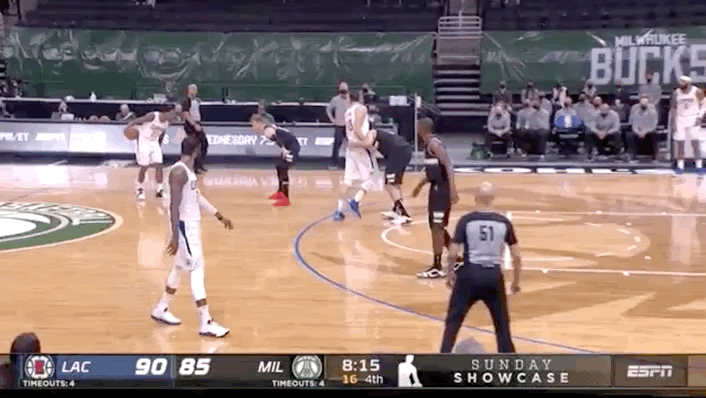
THE NUMBERS
Add that up and what do you
have? A guy averaging 29.1 points, 11.8 rebounds, 6.2 assists, 1.3
steals, and 1.3 blocks. He and Jokic are the
only two players
averaging at least 25-10-5, and
Jokic drops off the list once you add a steal
and a block to the qualifications.
The Bucks’ shot quality
increases leaps and bounds with Giannis on the floor, per Cleaning
The Glass. Their opponent’s shot quality drops considerably -- less
rim shots, more middies -- with Giannis patrolling the
area.
The Bucks are 13.7 points per
100 possessions better with
Giannis on the
floor, with an
offensive and defensive rating that would top the
leaderboards if extrapolated over a full season. That plus-13.7
differential outpaces LeBron (plus-13.4), Lillard (plus-9.2), Jokic
(plus-6.3), and Harden (plus-4.8). He’s slightly behind Embiid
(plus-14.2), but Embiid missing time due to injury may, fairly or
not, knock him down a couple of pegs in the MVP race.
This is a stacked field in a
weird season. I get it. But please, let’s not overthink this. Find
a player that tops Giannis’ stats, his impact on winning,
availability and narrative and you’ll have your MVP.
You can’t, can you?
:filters:quality(95)/images/story/2134/15540440_lg_690w.jpg)







:filters:quality(95)/images/assets/BasketballNews-Beta%403x.png)